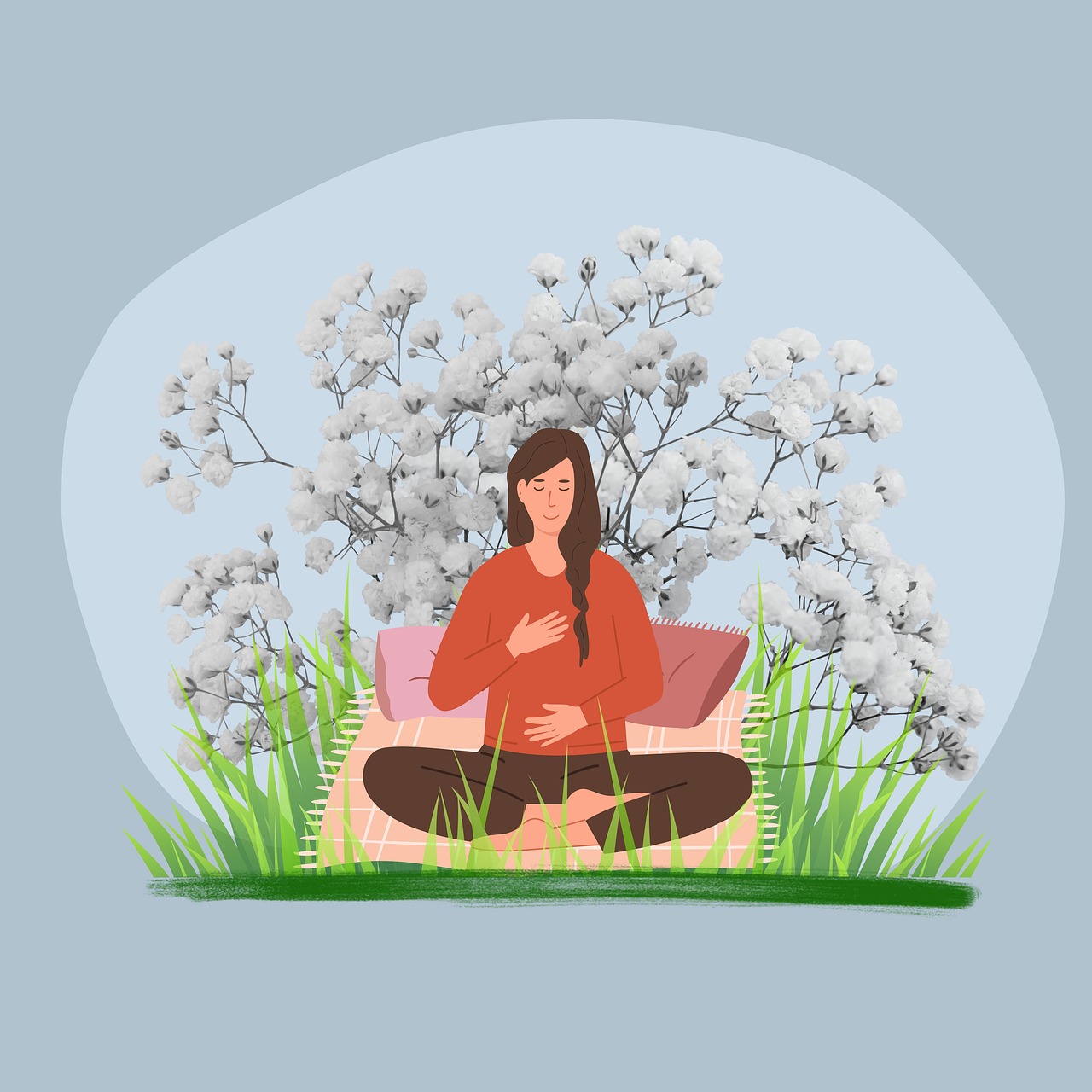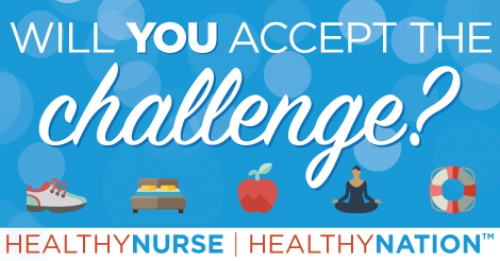Healthy Nurse, Healthy Nation® Guest Blog: Breathe to Heal: How a Simple Practice Can Support Stressed-Out Nurses
Published
Guest blogger shares the results of her and fellow researchers’ recent study on breath work and nurse stress
By Rajitha Bommakanti, BSN, RN, FCN, NBC-HWC
Nursing is a deeply meaningful profession but it's also one of the most stressful. Long hours, critical decision making, and chronic understaffing especially during and after the COVID-19 pandemic have left many nurses overwhelmed and burned out (Duva et al., 2022; Falatah, 2021; Lee & Jang, 2020). Mounting pressure in clinical settings can lead to mental fatigue, emotional exhaustion, and reduced clarity in patient care (Balaji & Varne, 2017; Ibrahim et al., 2022; Solomon, 2022).
So how can we help the very people who care for everyone else?
A recent pilot study explored whether a simple breathing practice, known as pranayama, rooted in ancient yogic traditions, could offer a solution (Bommakanti, Bouvier, & Higgins, 2025). The goal was to see if incorporating short, structured breathing exercises into nurses’ daily routines could improve their well-being and help manage stress.
The Study in a Nutshell
Nineteen nurses from a community hospital participated in the study. After completing baseline assessments, they were trained in three types of pranayama:
Participants were encouraged to practice daily morning and midday sessions over two months. Surveys assessing stress and well-being were completed at baseline, one month, and two months.
While the sample size was small, and participation tapered off due to time constraints and lack of institutional support, the results were promising. Nurses who consistently practiced pranayama reported improved well-being, even though stress reduction wasn’t statistically significant.
Challenges in Implementation
The drop in participation from 39 interested nurses to only 8 completing all phases highlights real world barriers. Heavy workloads, shift changes, skepticism about breathing as a legitimate stress management tool, and the absence of incentives all played a role.
These findings reflect a broader truth: nurses are more likely to adopt wellness practices when these are supported by leadership, easily accessible, and integrated into the culture of care.
Why It Matters
Even though this was a small pilot study, the implications are powerful. Pranayama is low-cost, non-pharmacologic, and easy to learn. Embedding short breathing practices into daily huddles, onboarding sessions, or wellness breaks could provide a grounding moment in otherwise hectic shifts. Healthcare systems must begin investing in preventive strategies that care for their caregivers not just during crises, but consistently.
What’s Next?
To build on these insights, larger studies across multiple hospitals are needed. Future research should explore long-term outcomes like job satisfaction, burnout prevention, and even patient care quality.
Programs like the Healthy Nurse, Healthy Nation initiative underscore a growing awareness of the need to protect and promote nurses’ health. Incorporating pranayama into such national efforts could create ripple effects not just for individual nurses, but for the healthcare system as a whole.
Inhale, Exhale, Heal
The takeaway. Breathing isn’t just automatic it can be intentional. A few minutes of guided breath each day could support nurses in navigating the demands of their profession with more calm, clarity, and resilience.
Because when we care for nurses, everyone benefits.
Rajitha Bommakanti is a dedicated nursing professional committed to promoting nurses' health and well-being. Through evidence-based holistic coaching, she inspires and empowers individuals to confidently overcome challenges and reach their full potential.
References
Balaji, P. A., & Varne, S. R. (2017). Physiological effects of meditation, yogasana and pranayama on stress scores and plasma cortisol levels among nursing staff of a multispeciality hospital. International Journal of Physiology, Nutrition and Physical Education, 2(1), 96-98. https://www.journalofsports.com/pdf/2017/vol2issue1/PartB/2-1-19-717.pdf
Bommakanti, R., Bouvier, M., & Higgins, M. (2025). The role of rhythmic breathing in stress reduction and well-being: A pilot study. Building Healthy Academic Communities Journal, 9(2), 49-59. https://doi.org/10.18061/10.18061/bhac.v9i2.10335
Duva, I. M., Murphy, J. R., & Grabbe, L. (2022). A nurse-led, well-being promotion using the community resiliency model, Atlanta, 2020-2021. American Journal of Public Health, 112(S3), S271–S274. https://doi.org/10.2105/AJPH.2022.306821
Falatah R. (2021). The impact of the Coronavirus disease (COVID-19) pandemic on nurses' turnover intention: An integrative review. Nursing Reports (Pavia, Italy), 11(4), 787–810. https://doi.org/10.3390/nursrep11040075
Ibrahim, K., & Komariah, M., & Herliani, Y. (2022). The effect of mindfulness breathing meditation on psychological well-being: A quasi-experimental study among nurses working for COVID-19 patients. Holistic Nursing Practice, 36(1), 46–51. https://doi.org/10.1097/hnp.0000000000000464
Lee, E., & Jang, I. (2020). Nurses' fatigue, job stress, organizational culture, and turnover intention: A culture-work- health model. Western Journal of Nursing Research, 42(2), 108–116. https://doi.org/10.1177/0193945919839189
Solomon, S. G. (2022). Effect of anuloma and viloma pranayama on stress of nurses. International Journal of Advanced Psychiatric Nursing, 4(1), 7-11. https://doi.org/10.33545/26641348.2022.v4.i1a.74

Not a member of Healthy Nurse, Healthy Nation (HNHN) yet? Join today!
Join our monthly challenges at hnhn.org/challenges!
So how can we help the very people who care for everyone else?
A recent pilot study explored whether a simple breathing practice, known as pranayama, rooted in ancient yogic traditions, could offer a solution (Bommakanti, Bouvier, & Higgins, 2025). The goal was to see if incorporating short, structured breathing exercises into nurses’ daily routines could improve their well-being and help manage stress.
The Study in a Nutshell
Nineteen nurses from a community hospital participated in the study. After completing baseline assessments, they were trained in three types of pranayama:
- Ujjayi (victory breath)
- Bhastrika (bellows breath)
- Surya Bheda (right nostril breath)
Participants were encouraged to practice daily morning and midday sessions over two months. Surveys assessing stress and well-being were completed at baseline, one month, and two months.
While the sample size was small, and participation tapered off due to time constraints and lack of institutional support, the results were promising. Nurses who consistently practiced pranayama reported improved well-being, even though stress reduction wasn’t statistically significant.
Challenges in Implementation
The drop in participation from 39 interested nurses to only 8 completing all phases highlights real world barriers. Heavy workloads, shift changes, skepticism about breathing as a legitimate stress management tool, and the absence of incentives all played a role.
These findings reflect a broader truth: nurses are more likely to adopt wellness practices when these are supported by leadership, easily accessible, and integrated into the culture of care.
Why It Matters
Even though this was a small pilot study, the implications are powerful. Pranayama is low-cost, non-pharmacologic, and easy to learn. Embedding short breathing practices into daily huddles, onboarding sessions, or wellness breaks could provide a grounding moment in otherwise hectic shifts. Healthcare systems must begin investing in preventive strategies that care for their caregivers not just during crises, but consistently.
What’s Next?
To build on these insights, larger studies across multiple hospitals are needed. Future research should explore long-term outcomes like job satisfaction, burnout prevention, and even patient care quality.
Programs like the Healthy Nurse, Healthy Nation initiative underscore a growing awareness of the need to protect and promote nurses’ health. Incorporating pranayama into such national efforts could create ripple effects not just for individual nurses, but for the healthcare system as a whole.
Inhale, Exhale, Heal
The takeaway. Breathing isn’t just automatic it can be intentional. A few minutes of guided breath each day could support nurses in navigating the demands of their profession with more calm, clarity, and resilience.
Because when we care for nurses, everyone benefits.
Rajitha Bommakanti is a dedicated nursing professional committed to promoting nurses' health and well-being. Through evidence-based holistic coaching, she inspires and empowers individuals to confidently overcome challenges and reach their full potential.
References
Balaji, P. A., & Varne, S. R. (2017). Physiological effects of meditation, yogasana and pranayama on stress scores and plasma cortisol levels among nursing staff of a multispeciality hospital. International Journal of Physiology, Nutrition and Physical Education, 2(1), 96-98. https://www.journalofsports.com/pdf/2017/vol2issue1/PartB/2-1-19-717.pdf
Bommakanti, R., Bouvier, M., & Higgins, M. (2025). The role of rhythmic breathing in stress reduction and well-being: A pilot study. Building Healthy Academic Communities Journal, 9(2), 49-59. https://doi.org/10.18061/10.18061/bhac.v9i2.10335
Duva, I. M., Murphy, J. R., & Grabbe, L. (2022). A nurse-led, well-being promotion using the community resiliency model, Atlanta, 2020-2021. American Journal of Public Health, 112(S3), S271–S274. https://doi.org/10.2105/AJPH.2022.306821
Falatah R. (2021). The impact of the Coronavirus disease (COVID-19) pandemic on nurses' turnover intention: An integrative review. Nursing Reports (Pavia, Italy), 11(4), 787–810. https://doi.org/10.3390/nursrep11040075
Ibrahim, K., & Komariah, M., & Herliani, Y. (2022). The effect of mindfulness breathing meditation on psychological well-being: A quasi-experimental study among nurses working for COVID-19 patients. Holistic Nursing Practice, 36(1), 46–51. https://doi.org/10.1097/hnp.0000000000000464
Lee, E., & Jang, I. (2020). Nurses' fatigue, job stress, organizational culture, and turnover intention: A culture-work- health model. Western Journal of Nursing Research, 42(2), 108–116. https://doi.org/10.1177/0193945919839189
Solomon, S. G. (2022). Effect of anuloma and viloma pranayama on stress of nurses. International Journal of Advanced Psychiatric Nursing, 4(1), 7-11. https://doi.org/10.33545/26641348.2022.v4.i1a.74

Not a member of Healthy Nurse, Healthy Nation (HNHN) yet? Join today!
Join our monthly challenges at hnhn.org/challenges!
Blog Quality of Life
10/14/2025 9:20am CDT



Post a Comment or Question